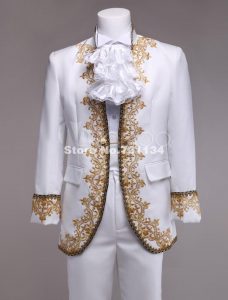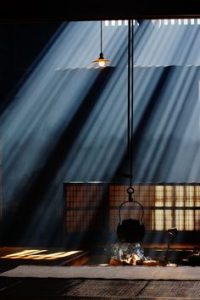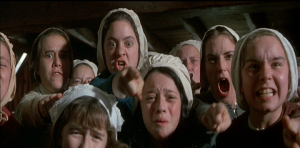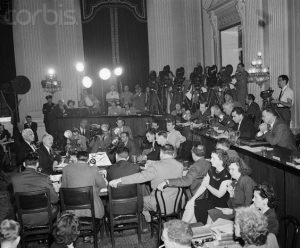If you read The Crucible, and really think about what is going on, the play becomes terrifying. This story tells how the drive for power and control can corrupt the mind and the community. This story shows how fear can consume everything that remains good, pure, and true with an icy darkness that destroys the foundations of our lifestyle. This play also tells a story that happened over three hundred years ago, and as a result, it is treated like a piece of historical fiction. Modern high school students read this play in their American Literature class as a case study of the idiocy and incredulity of those who founded the United States. We relate it to the communist hunt that took place over half a century ago and think to ourselves that we have learned. We forget that our fledgling president of a few months used xenophobia, racial profiling, and a dash of white supremacy and privilege to take control of our country and jeopardize our standing in the global community. The Crucible matters today. It represents everything we can become if we are not careful. It showcases the darkest sides of the human spirit which we must continue to fight if we are to truly better ourselves, our lives, and our communities. This play should make the audiences who view it very afraid, and it should transform those who see it so they reject the terror and blind control that seeks to squash out opposition and discussion. This play fights for the life of the American spirit, and because this fight currently comes to our cellphones with every passing hour, it should be performed today. After all, politicians post: This new production of The Crucible will be comprehensive, and it will utilize its many distinct and necessary parts to tell the story of this play. The actors will be trained extensively with the Meisner improvisational exercise in order to develop a company that truly listens and responds to one another. The focus will be on developing partner work in an environment of trust where there exists total and complete honesty on stage. The crux of The Crucible lies not in the spectacle of the trials, but in the relationships between the characters. The two-person scenes between John and Elizabeth serve as the backbone of the drama, and when the interactions between John and Abigail, the young girls with each other, and the court scenes are added in, they must build off of this backbone of partner work. There will be a spectrum of physicality portrayed by the actors. Those on the virtuous side will exhibit naturalistic behavior, but they will be characterized by their restraint and complexity of emotion. Those behind the bench will be large and brooding, seemingly unrefined but viscerally imposing on those they interact with. They should evoke the stereotypically corrupt U.S. Senator of the McCarthy era.
This new production of The Crucible will be comprehensive, and it will utilize its many distinct and necessary parts to tell the story of this play. The actors will be trained extensively with the Meisner improvisational exercise in order to develop a company that truly listens and responds to one another. The focus will be on developing partner work in an environment of trust where there exists total and complete honesty on stage. The crux of The Crucible lies not in the spectacle of the trials, but in the relationships between the characters. The two-person scenes between John and Elizabeth serve as the backbone of the drama, and when the interactions between John and Abigail, the young girls with each other, and the court scenes are added in, they must build off of this backbone of partner work. There will be a spectrum of physicality portrayed by the actors. Those on the virtuous side will exhibit naturalistic behavior, but they will be characterized by their restraint and complexity of emotion. Those behind the bench will be large and brooding, seemingly unrefined but viscerally imposing on those they interact with. They should evoke the stereotypically corrupt U.S. Senator of the McCarthy era. Abigail will be cast as an alluring beauty, but her style of movement will reflect innocence and youth. She will be playful and exciting, moving with the innocuously carefree nature of a child that arbors immense intelligence and control. Among the falsely accused, including John, Elizabeth, Giles, and Rebecca, no attention will be given to race in casting. All parts will be open and cast solely on the ability of the actors to work with a partner, respond in the moment, and live truthfully under the imaginary circumstances. Parris, Herrick, Hathorne, and Danforth will be cast white, along with the young girls, in tradition with the racial superiority that they will self-righteously exude as the source of their power.
Abigail will be cast as an alluring beauty, but her style of movement will reflect innocence and youth. She will be playful and exciting, moving with the innocuously carefree nature of a child that arbors immense intelligence and control. Among the falsely accused, including John, Elizabeth, Giles, and Rebecca, no attention will be given to race in casting. All parts will be open and cast solely on the ability of the actors to work with a partner, respond in the moment, and live truthfully under the imaginary circumstances. Parris, Herrick, Hathorne, and Danforth will be cast white, along with the young girls, in tradition with the racial superiority that they will self-righteously exude as the source of their power.
The costuming choice will be a subversion of the play’s typical characterization of black and white. Our heroes, John and Elizabeth, will be dressed in Earth tones, changing throughout their appearances to not tie them to any particular color.  The period of the costumes will start historically accurate in the play’s beginning, but they will be continuously changing throughout each scene and act to become more modern. By Act III, the protagonists should be dressed for a court hearing of the 1950s, and by the play’s end, they would appear ready to exit the stage and get a casual dinner today. The key to the costuming is simplicity and earthiness for these characters.
The period of the costumes will start historically accurate in the play’s beginning, but they will be continuously changing throughout each scene and act to become more modern. By Act III, the protagonists should be dressed for a court hearing of the 1950s, and by the play’s end, they would appear ready to exit the stage and get a casual dinner today. The key to the costuming is simplicity and earthiness for these characters.  The law will be dressed in pure white as they arrive, not excessively opulent, but as if assuring themselves of their divinity. Hale will change continuously, muddled between his white attire and more natural tones as he grapples with his conscious. Parris will transition slowly from all white to a large suit with a large red stain as he realizes his failures and errors by the very end.
The law will be dressed in pure white as they arrive, not excessively opulent, but as if assuring themselves of their divinity. Hale will change continuously, muddled between his white attire and more natural tones as he grapples with his conscious. Parris will transition slowly from all white to a large suit with a large red stain as he realizes his failures and errors by the very end.  Makeup will be treated simply also, with the exception of Abigail, who will transform from an innocent youth to a transfixing beauty. Her white clothing, like the white cloth of everyone else, will become splashed with an increasing amount of red liquid, resembling blood. In Act III, she will appear in a red dress, starkly contrasting the simplicity of those around her.
Makeup will be treated simply also, with the exception of Abigail, who will transform from an innocent youth to a transfixing beauty. Her white clothing, like the white cloth of everyone else, will become splashed with an increasing amount of red liquid, resembling blood. In Act III, she will appear in a red dress, starkly contrasting the simplicity of those around her. The scenic design will consist of a singular large room, with various set pieces brought in to scarcely evoke the changes in location. About ten feet above the stage, the walls will tilt in and form a cathedral ceiling of skylights. These skylights should be made of thick glass so that light can go through, but no members of the audience can see through the panels from their position.
The scenic design will consist of a singular large room, with various set pieces brought in to scarcely evoke the changes in location. About ten feet above the stage, the walls will tilt in and form a cathedral ceiling of skylights. These skylights should be made of thick glass so that light can go through, but no members of the audience can see through the panels from their position. Above, the lighting design will evoke natural light, whether the moon, sun, or changes throughout the day. The lighting will cast shadows over various elements of the set, and it will evoke the passage of time as well as the time of day. Actors will be blocked so that their faces are fully illuminated during speaking, despite the darkened nature of the lighting design. No effects that could not be reproduced with natural light, candles, lamps, or photography flashes will be used.
Above, the lighting design will evoke natural light, whether the moon, sun, or changes throughout the day. The lighting will cast shadows over various elements of the set, and it will evoke the passage of time as well as the time of day. Actors will be blocked so that their faces are fully illuminated during speaking, despite the darkened nature of the lighting design. No effects that could not be reproduced with natural light, candles, lamps, or photography flashes will be used.  As the passage of time in costuming occurs, the décor will become more and more modern as well, and the lighting will transition from natural effects and candle lit rooms to increasingly modern electric lights. During Act III, a large influence on the lighting will be the strobe-like effect created from flash-bulbs on mid century cameras. These flashes will intensify and wane throughout the action of the Act. At the play’s close, the effect will be similar, but done with smartphones and live-streaming devices that capture the execution of John Proctor. (The desired effect is displayed well in the below video between 1:10 and 1:15)
As the passage of time in costuming occurs, the décor will become more and more modern as well, and the lighting will transition from natural effects and candle lit rooms to increasingly modern electric lights. During Act III, a large influence on the lighting will be the strobe-like effect created from flash-bulbs on mid century cameras. These flashes will intensify and wane throughout the action of the Act. At the play’s close, the effect will be similar, but done with smartphones and live-streaming devices that capture the execution of John Proctor. (The desired effect is displayed well in the below video between 1:10 and 1:15)
The sound design will undergo a similar amalgamation. No extraneous sound effects will be used, but there will be heavy emphasis on music, meant to show how this witch-hunt is built up continuously and precariously. The early music will be very similar to Jonny Greenwood’s score from There Will Be Blood (listen at http://www.what-song.com/Movies/Soundtrack/273/There-Will-Be-Blood), and will emphasize scant instrumentals based in percussion and string pieces evoked in works such as Arvo Part’s “Fratres.”
This music will age into a more electric form throughout the show, with heavy intensity at the ends of each act, and will eventually evolve into Apollo Sunshine’s “We Are Born When We Die” in the plays final scene.
The music will be embedded throughout the theater, emanating from the undersides of seats and the aisles just as much as it comes from the stage.
These aspects give an idea of the aesthetic that the production will encapsulate, and they allude to the creeping modernity which will consume the play by its end. In the opening, the dancing scene will be performed before the dialogue begins, but instead of drawing back towards the movie’s opening scene, this production will showcase the playful and innocent nature of the girls and Tituba. They will seem neither malevolent in their play nor have any intentions of what will happen later in the piece. Throughout the opening scenes where Betty is bedridden, the audience will clearly see conversation between Betty and Abigail, and the play will appear light and forgivable with little more going on than a harmless prank. However, when the audience falls into the humor of this seen, it will begin to change. Once their guards have been let down, the fear of Parris and his cronies will begin to surface, and there will be a noticeable shift as the girls realize they will have to dig a deeper hole to get out of trouble. The funny and carefree interpretation of the play’s beginning will be completely overturned by the time Tituba is questioned, and fear will engulf the stage as the girls begin to realize what is going on.  By the ending of Act I, the girls will fanatically yell accusations of their neighbors as witches, but it will not stop there. The lights will come up violently on the audience, and the accusations will flow into the crowd. People will randomly be labeled Communist, Jew, Muslim, Black, Gay, Trans, and a full host of racially and culturally appropriative epithets meant to unsettle the audience. They will be subjected by the girls on stage but also, simplistically dressed planted audience members who jump into the aisles and begin accusing those around them.
By the ending of Act I, the girls will fanatically yell accusations of their neighbors as witches, but it will not stop there. The lights will come up violently on the audience, and the accusations will flow into the crowd. People will randomly be labeled Communist, Jew, Muslim, Black, Gay, Trans, and a full host of racially and culturally appropriative epithets meant to unsettle the audience. They will be subjected by the girls on stage but also, simplistically dressed planted audience members who jump into the aisles and begin accusing those around them. It will become clear from this point on that the trials are very real, and not only witches are being subjected to the horrors going on in this production.
It will become clear from this point on that the trials are very real, and not only witches are being subjected to the horrors going on in this production.
Act II will seem far more restrained in comparison to Act I, but this juxtaposition remains necessary to fully develop the relationship between John and Elizabeth. This Act will not feature any deconstructive or in-yerr-face elements, but it will be continuously displaying the shifting times in fashion, setting, lighting, and music. Act III will be the most deconstructive of all. Those testifying will be taken down to tables in the front of the auditorium, while Danforth and the girls will be placed on stage in what will appear to be a HUAC hearing. The upper balcony will be filled with photographers continuously flashing in rhythm with the intensity of the scene.  The large dark bird that Abigail claims to see will be replaced with Big Brother, while the others see the racially motivated caricatures created to degrade so many minorities throughout American history. The feeling of the play will have departed completely from the historical nature of the witch trials, but the devil will remain a constant in the dialogue. The audience will be made to understand that in this court, the devil represents everything that comes between the “idyllic American whiteness” of those running the show and their power.
The large dark bird that Abigail claims to see will be replaced with Big Brother, while the others see the racially motivated caricatures created to degrade so many minorities throughout American history. The feeling of the play will have departed completely from the historical nature of the witch trials, but the devil will remain a constant in the dialogue. The audience will be made to understand that in this court, the devil represents everything that comes between the “idyllic American whiteness” of those running the show and their power.
Act IV will be less intensive on the audience. The cells will be modern, but grim, and the dress will begin to approach that of the politicians we know today. Parris’s suit will be stained with a long red smear down the front, resembling a long red tie. This act will step away from the spectacle, and focus on the fear and regret that these characters have come to experience. By the time we get to the confession, Proctor is not signing his name but meant to post it online for the world to see. His clothing becomes noticeable similar in its whiteness to the others as he steps away from his virtue and honesty, but as he repents and destroys the source of his confession, these white coverings are ripped off, leaving him bare-chested and weak in his physical body but still strong in his convictions.
This act will step away from the spectacle, and focus on the fear and regret that these characters have come to experience. By the time we get to the confession, Proctor is not signing his name but meant to post it online for the world to see. His clothing becomes noticeable similar in its whiteness to the others as he steps away from his virtue and honesty, but as he repents and destroys the source of his confession, these white coverings are ripped off, leaving him bare-chested and weak in his physical body but still strong in his convictions. Instead of the gallows, Proctor is taken to a firing squad as the last song begins to play. He stands center stage facing the audience, with Parris and four others behind him ready to fire. The natural lighting of the glass panels finally expires into an eerily dark night, Elizabeth says her final line, and then the squad fires. Throughout this production, the conflict must become terrifying through the fact that it becomes increasingly close to home. The audience should be fearful in their victimization and commiserate with those executed in Salem. However, Proctor’s ending, though tragic, offers a glimmer of hope, and the company has the sacred duty of protecting this hope and projecting it onto the audience through the story they tell so that these people can be touched in their own lives.
Instead of the gallows, Proctor is taken to a firing squad as the last song begins to play. He stands center stage facing the audience, with Parris and four others behind him ready to fire. The natural lighting of the glass panels finally expires into an eerily dark night, Elizabeth says her final line, and then the squad fires. Throughout this production, the conflict must become terrifying through the fact that it becomes increasingly close to home. The audience should be fearful in their victimization and commiserate with those executed in Salem. However, Proctor’s ending, though tragic, offers a glimmer of hope, and the company has the sacred duty of protecting this hope and projecting it onto the audience through the story they tell so that these people can be touched in their own lives.
Images from top to bottom: [1] https://www.google.com/search?q=fear+trump+tweets&source=lnms&tbm=isch&sa=X&ved=0ahUKEwjYiYXGqKDUAhXJ1IMKHVLSAoYQ_AUICygC&biw=1166&bih=945#imgrc=XFG3e5vS3L2tRM: [2] http://www.dailymail.co.uk/news/article-1363876/The-new-McCarthy-Senator-branded-hearings-Muslim-threat-U-S.html [3] http://www.boomerinas.com/2015/08/17/what-are-earth-tone-colors-a-fashion-question-for-the-ages/ [4] http://www.dhgate.com/store/product/2015-high-end-customized-black-red-white/237019225.html [5] http://www.mensjournal.com/expert-advice/how-to-get-rid-of-stains-20131114 [6] https://uk.pinterest.com/explore/classy-red-dress/ [7] https://www.pinterest.com/pin/144255994286379989/ [8] https://www.pinterest.com/angelena413/stage-design/ [9] http://villains.wikia.com/wiki/The_Salemite_Girls_(The_Crucible) [10] https://www.washingtonpost.com/video/politics/angry-utahns-pack-chaffetzs-home-state-town-hall/2017/02/10/8ca75d8e-ef80-11e6-a100-fdaaf400369a_video.html [11]https://www.google.com/search?biw=1166&bih=945&tbm=isch&sa=1&q=huac+hearings&oq=huac+hearings&gs_l=psy-ab.3..0j0i24k1l3.191318.194114.0.194280.13.13.0.0.0.0.212.1569.0j9j1.10.0….0…1.1.64.psy-ab..3.10.1567…0i67k1.OdFbXyHjux8#imgdii=Z-6-7q5M5KOS7M:&imgrc=JGSJmD0vsTsg6M: [12] http://www.nydailynews.com/entertainment/theater-arts/meryl-streep-takes-stage-donald-trump-article-1.2663812 [13] https://some-trace-of-her.tumblr.com/post/143310704039/ben-whishaw-as-john-proctor-in-the-crucible-my
Videos top to bottom: [1] “Harry Potter & The Deathly Hallows: Part 1 (2010) Official Opening Scene.” YouTube, uploaded by luipotteropenings, 23 Sep 2012, https://www.youtube.com/watch?v=uffmqrjaSh4 [2] “Arvo Part – Fratres.” Youtube, uploaded by pelodelperro, 16 Dec 2009, https://www.youtube.com/watch?v=7vdgZAJVnes&index=6&list=PLaucXuwTx3L8UOAoHnQtJFECqFSSjN0ro [3] “Apollo Sunshine – We Are Born When We Die.” YouTube, uploaded by Ugur O., 4 Oct 2011, https://www.youtube.com/watch?v=GKAgo-g5V2E
